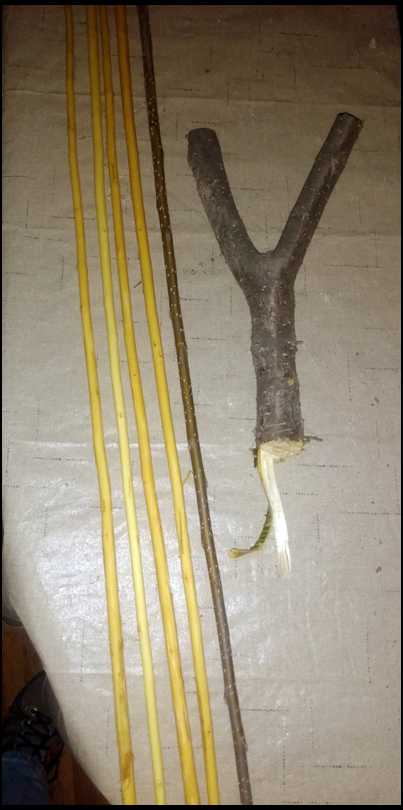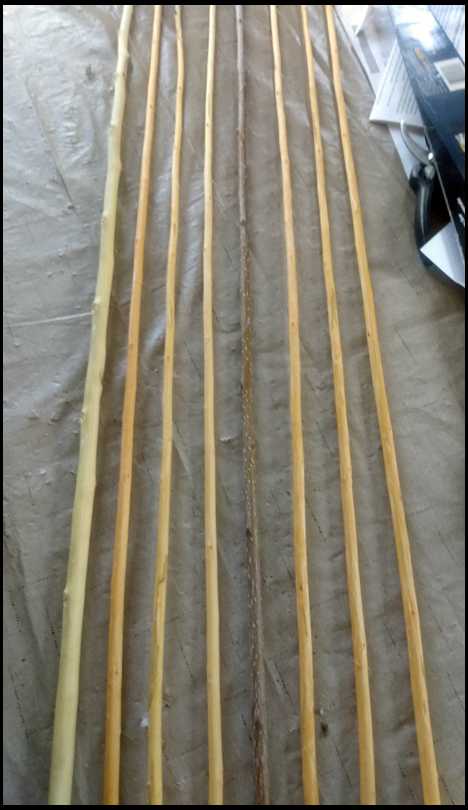| From: Frisky
|
|
|
|
|
|
|
| Date: 19-May-20 |
|

Folks, now is the time to go find some shoots and turn them into arrows. I’ll soon be posting a video on how and when this was done by most native tribesmen. This business of collecting shoots, bundling them, and seasoning them is a bunch of bunk. Native Americans were conservationists, and as I’ve said before, the #1 thing they conserved was energy. They weren’t going to mess with bundling and carrying a bunch of bundled shafts with them. They would have bundled late season shafting, but most arrow making would have been done in the spring. When my video is out, watch it, as you’ll likely agree with me, as bad as the video is going to be. I’m only doing a video because some people asked me if I would do so. In this photo, you see 5 shoots. I immediately peeled the bark off 4 of them, as shown, and the 5th was a dead but not rotten shoot, so the bark won’t peel off. These shoots are thinner than I’d normally select, but they’ll make great arrows for kids. I just cut them, because they were going to be mowed down. After peeling, I straightened them, by hand, in a few minutes. They were cut to about 42”.
|
|
| From: Frisky
|
|
|
|
|
|
|
| Date: 19-May-20 |
|

In this photo, I cut 3 additional shoots. The big shoot on the left is not one I’d normally cut. It’s an elm sapling that grew through the fence and had to be removed. It’s less than ideal, but I decided to make it into an arrow. This is day #3. You can see, they’re about as straight as a shoot shaft can be. They still take corrections, but few are needed.
|
|
| From: Frisky
|
|
|
|
|
|
|
| Date: 19-May-20 |
|

Here you see the shoots cut to 30” and ready to turn into shafting. The fat ends cracked for about 1”, but that is cut away. When the cracking forms on the fat end, it tells you the shoot is ready to cut to length. Next, I’ll do some light scraping on the shafts and put a taper where the field point will be. The fatter shafts will have a self-nock cut. Then, all shafts will be fire hardened. Fire actually strengthens them and seasons them a good 2 years in 3 or 4 minutes! In all, it took an ancient arrow maker about 4 days to go from cut shoot to completed arrow shaft. There was no need to lug them around for years, as the old wise guys will tell you. It’s best to let the old guys dream their dreams, while you pay attention to those of us who know what’s going on.
Joe
|
|
| From: Lost arrow
|
|
|
|
|
|
|
| Date: 19-May-20 |
|
Looking forward to your video. Would Black Gum, (Tupelo) shoots make decent arrows ?
|
|
| From: Old School
|
|
|

|
|
|
|
| Date: 19-May-20 |
|
Joe, what kind of shoots will you use? Which do you prefer? Thanks
|
|
| From: fdp
|
|
|
|
|
|
|
| Date: 19-May-20 |
|
Pretty cool so far Frisky.
|
|
| From: Backcountry
|
|
|
|
|
|
|
| Date: 19-May-20 |
|
Frisky appears to favor shoots to be about 12 gauge, based on another thread he started.
|
|
| From: Frisky
|
|
|
|
|
|
|
| Date: 19-May-20 |
|
Any hardwood should work fine, as long as the thin end comes out at around 3/8th inches for a self-nock. If thinner than that, I use plastic nocks. The shoots shown here are either Gray Dogwood or Silky Dogwood. I'm going to check the blooms, on the remaining shoots, and see what species they are. They all work the same but have different surface textures. For example, willow has a waxy surface. Black Ash has bark that peels easily, and the wood under the bark has super fine grooving running the length of the shoot. Red Osier is smooth and almost white in color. Chokecherry and buckthorn are bumpy and yellowish.
I prefer Red Osier and Black Ash. You know a Black Ash, as they have compound leaves with 7 leaves on each stem.
Joe
|
|
|
|
| From: Frisky
|
|
|
|
|
|
|
| Date: 19-May-20 |
|
Old School- You might also look into river cane and wild rose. I don't have them here.
Joe
|
|
| From: Frisky
|
|
|
|
|
|
|
| Date: 19-May-20 |
|
A word about the buckthorn slingshot fork. If you cut one, wait 6 weeks before removing the bark. If I was to remove the bark now, it would split almost in half in a few days! Around the 1st of July, I'll cut the uprights and grip to length and carve away the bark. It's only in the photo, as I got it at the same time as the shoots.
Joe
|
|
| From: JimG
|
|
|
|
|
|
|
| Date: 19-May-20 |
|
|
|
| From: WATERMOCCASIN
|
|
|
|
|
|
|
| Date: 19-May-20 |
|
If one end is a little thicker,which end is the nock put in?
|
|
| From: Frisky
|
|
|
|
|
|
|
| Date: 19-May-20 |
|
I always place the nock at the top end or thin end. Some do the opposite.
Joe
|
|
| From: Frisky
|
|
|
|
|
|
|
| Date: 20-May-20 |
|
Yes, the tapers are nice! Another advantage of peeling off the bark in the spring, is you don't have to sand or scrape 2/3s of the length of each shaft. Only the fattest 1/3.
Joe
|
|
|
|
| From: Frisky
|
|
|
|
|
|
|
| Date: 21-May-20 |
|
Jawge- I might hunt with shoot shafts this season.
Joe
|
|
If you have already registered, please sign in now
For new registrations Click Here
|
|
|
|



